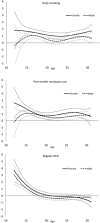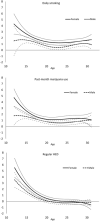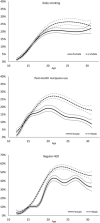Age-varying associations between substance use behaviors and depressive symptoms during adolescence and young adulthood
- PMID: 26483358
- PMCID: PMC4663168
- DOI: 10.1016/j.drugalcdep.2015.10.005
Age-varying associations between substance use behaviors and depressive symptoms during adolescence and young adulthood
Abstract
Background: Substance use and depression often co-occur, complicating treatment of both substance use and depression. Despite research documenting age-related trends in both substance use and depression, little research has examined how the associations between substance use behaviors and depression changes across the lifespan.
Methods: This study examines how the associations between substance use behaviors (daily smoking, regular heavy episodic drinking (HED), and marijuana use) and depressive symptoms vary from adolescence into young adulthood (ages 12-31), and how these associations differ by gender. Using data from the National Longitudinal Study of Adolescent to Adult Health (Add Health), we implemented time-varying effect models (TVEM), an analytic approach that estimates how the associations between predictors (e.g., substance use measures) and an outcome (e.g., depressive symptoms) vary across age.
Results: Marijuana use and daily smoking were significantly associated with depressive symptoms at most ages from 12 to 31. Regular HED was significantly associated with depressive symptoms during adolescence only. In bivariate analyses, the association with depressive symptoms for each substance use behavior was significantly stronger for females at certain ages; when adjusting for concurrent substance use in a multivariate analysis, no gender differences were observed.
Conclusions: While the associations between depressive symptoms and both marijuana and daily smoking were relatively stable across ages 12-31, regular HED was only significantly associated with depressive symptoms during adolescence. Understanding age and gender trends in these associations can help tailor prevention efforts and joint treatment methods in order to maximize public health benefit.
Keywords: Adolescence; Age-varying effects; Comorbidity; Depression; Substance use; Young adulthood.
Copyright © 2015 Elsevier Ireland Ltd. All rights reserved.
Conflict of interest statement
Conflict of Interest: No conflict declared
Figures




Similar articles
-
Directions of the relationship between substance use and depressive symptoms from adolescence to young adulthood.Addict Behav. 2016 Sep;60:64-70. doi: 10.1016/j.addbeh.2016.03.036. Epub 2016 Apr 2. Addict Behav. 2016. PMID: 27100470 Free PMC article.
-
Gender, depressive symptoms, and daily cigarette use.J Dual Diagn. 2014;10(4):187-96. doi: 10.1080/15504263.2014.961852. J Dual Diagn. 2014. PMID: 25391276 Free PMC article.
-
Changes in gender and racial/ethnic disparities in rates of cigarette use, regular heavy episodic drinking, and marijuana use: ages 14 to 32.Addict Behav. 2015 Feb;41:218-22. doi: 10.1016/j.addbeh.2014.10.029. Epub 2014 Nov 4. Addict Behav. 2015. PMID: 25452068 Free PMC article.
-
Unlocking the age-old secrets of reward and substance use.Pharmacol Biochem Behav. 2024 Jun;239:173766. doi: 10.1016/j.pbb.2024.173766. Epub 2024 Apr 9. Pharmacol Biochem Behav. 2024. PMID: 38604456 Review.
-
A meta-analysis of the relationship between trait mindfulness and substance use behaviors.Drug Alcohol Depend. 2014 Oct 1;143:1-10. doi: 10.1016/j.drugalcdep.2014.07.014. Epub 2014 Jul 24. Drug Alcohol Depend. 2014. PMID: 25113434 Free PMC article. Review.
Cited by
-
Examination of cumulative effects of early adolescent depression on cannabis and alcohol use disorder in late adolescence in a community-based cohort.Addiction. 2017 Nov;112(11):1952-1960. doi: 10.1111/add.13907. Epub 2017 Jul 17. Addiction. 2017. PMID: 28600897 Free PMC article.
-
Daily patterns of single and poly-substance use among adolescent and young adult females: A day-level latent class analysis.Addict Behav. 2025 Oct;169:108394. doi: 10.1016/j.addbeh.2025.108394. Epub 2025 Jun 2. Addict Behav. 2025. PMID: 40480140
-
Depression screening outcomes among adolescents, young adults, and adults reporting past 30-day tobacco and cannabis use.Addict Behav. 2024 Sep;156:108076. doi: 10.1016/j.addbeh.2024.108076. Epub 2024 May 28. Addict Behav. 2024. PMID: 38838604 Free PMC article.
-
Tobacco smoking and depressive symptoms in Chinese middle-aged and older adults: Handling missing values in panel data with multiple imputation.Front Public Health. 2022 Aug 26;10:913636. doi: 10.3389/fpubh.2022.913636. eCollection 2022. Front Public Health. 2022. PMID: 36091567 Free PMC article.
-
Peer victimization and substance use: Understanding the indirect effect of depressive symptomatology across gender.Addict Behav. 2018 Sep;84:160-166. doi: 10.1016/j.addbeh.2018.04.010. Epub 2018 Apr 13. Addict Behav. 2018. PMID: 29698871 Free PMC article.
References
-
- Acierno R, Kilpatrick DG, Resnick H, Saunders B, De Arellano M, Best C. Assault, PTSD, family substance use, and depression as risk factors for cigarette use in youth: findings from the National Survey of Adolescents. J Trauma Stress. 2000;13:381–396. - PubMed
-
- Brown BS, O'Grady K, Battjes RJ, Farrell EV. Factors associated with treatment outcomes in an aftercare population. Am J Addict. 2004;13:447–460. - PubMed
Publication types
MeSH terms
Grants and funding
LinkOut - more resources
Full Text Sources
Other Literature Sources
Medical

